High-end features as standard
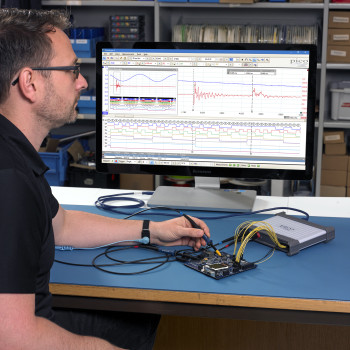
High bandwidth, high sampling rate
Despite the compact size and low cost, there is no compromise on performance, with bandwidths up to 200 MHz. This bandwidth is matched by a real-time sampling rate of 1 GS/s, allowing detailed display of high frequencies. With a real-time sampling rate of five times the input bandwidth, PicoScope 5000 Series oscilloscopes are well equipped to capture high-frequency signal detail. For repetitive signals, the maximum effective sampling rate can be boosted to 10 GS/s by using Equivalent Time Sampling (ETS) mode.

Serial bus decoding and analysis
With its deep memory, the PicoScope 5000D Series can decode 1-Wire, ARINC 429, CAN and CAN-FD, DCC, DMX512, Ethernet 10Base-T and 100Base-TX, FlexRay, I²C, I²S, LIN, PS/2, MODBUS, SENT, SPI, UART (RS-232 / RS-422 / RS-485) and USB 1.1 protocol data as standard.
Decoding helps you see what is happening in your design to identify programming and timing errors and check for other signal integrity issues.
Timing analysis tools help to show the performance of each design element, identifying parts of the design that need to be improved to optimize overall system performance.

Graph format shows the decoded data (in hex, binary, decimal or ASCII) in a timing diagram format, beneath the waveform on a common time axis, with error frames marked in red. You can zoom in on these frames to investigate noise or distortion, and each packet field is assigned a different color, so the data is easy to read.

Table format shows a list of the decoded frames, including the data and all flags and identifiers. You can set up filtering conditions to display only the frames you are interested in or search for frames with specified properties. The statistics option reveals more detail about the physical layer such as frame times and voltage levels. PicoScope can also import a spreadsheet to decode the data into user-defined text strings.
More information on Serial bus decoding and analysis
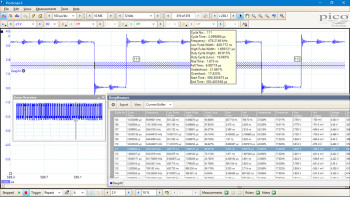
DeepMeasure
One waveform, millions of measurements
Measurement of waveform pulses and cycles is key to verification of the performance of electrical and electronic devices.
DeepMeasure delivers automatic measurements of important waveform parameters on up to a million waveform cycles with each triggered acquisition. Results can be easily sorted, analyzed and correlated with the waveform display.
More information on DeepMeasure

Waveform buffer and navigator
Ever spotted a glitch on a waveform, but by the time you’ve stopped the scope it has gone? With PicoScope you no longer need to worry about missing glitches or other transient events. PicoScope can store the last ten thousand oscilloscope waveforms or spectrum plots in its circular waveform buffer.
The buffer navigator provides an efficient way of navigating and searching through captured waveforms, effectively letting you turn back time.
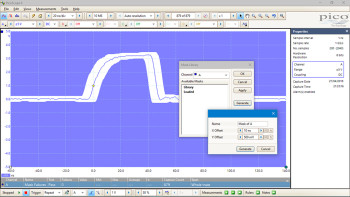
Mask limit testing
Mask limit testing allows you to compare live signals against known good signals, and is designed for production and debugging environments.
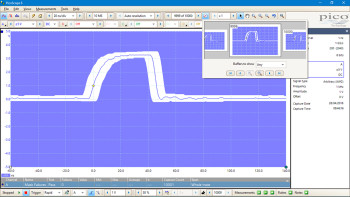
Simply capture a known good signal, draw a mask around it, and then attach the system under test. PicoScope will check for mask violations and perform pass/fail testing, capture intermittent glitches, and can show a failure count and other statistics in the Measurements window.
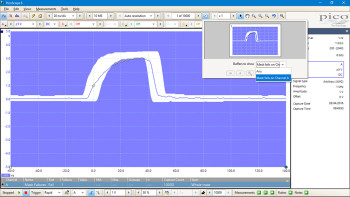
Use the Buffer navigator to find waveforms that violate the mask.
In this case 10 000 waveforms have been captured in the buffer. Just one of those waveforms, which violated the mask, is easily found by selecting "Mask fails on Channel A" in the navigator.
More information on Mask limit testing

Advanced digital triggering
The majority of digital oscilloscopes still use an analog trigger architecture based on comparators. This causes time and amplitude errors that cannot always be calibrated out and often limits the trigger sensitivity at high bandwidths.
In 1991 Pico pioneered the use of fully digital triggering using the actual digitized data. This technique reduces trigger errors and allows our oscilloscopes to trigger on the smallest signals, even at the full bandwidth. Trigger levels and hysteresis can be set with high precision and resolution.
The sub-1 µs rearm delay provided by digital triggering, together with segmented memory, allows up to 10 000 waveforms to be captured in a 10 ms burst.
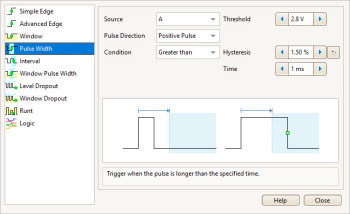
The PicoScope 5000 Series offers an industry-leading set of advanced triggers including pulse width, runt pulse, windowed, logic and dropout.

On PicoScope 5000D MSO models the digital channels can be used to form a logic trigger with Boolean operators.
More information on Advanced digital triggering

FFT spectrum analyzer
The spectrum view plots amplitude against frequency and is ideal for finding noise, crosstalk or distortion in signals. The spectrum analyzer in PicoScope is of the Fast Fourier Transform (FFT) type which, unlike a traditional swept spectrum analyzer, can display the spectrum of a single, non-repeating waveform.
A full range of settings gives you control over the number of spectrum bands (FFT bins), window types, scaling (including log/log) and display modes (instantaneous, average, or peak-hold).

You can display multiple spectrum views alongside oscilloscope views of the same data. A comprehensive set of automatic frequency-domain measurements can be added to the display, including THD, THD+N, SNR, SINAD and IMD. A mask limit test can be applied to a spectrum and you can even use the AWG and spectrum mode together to perform swept scalar network analysis.
More information on FFT spectrum analyzer